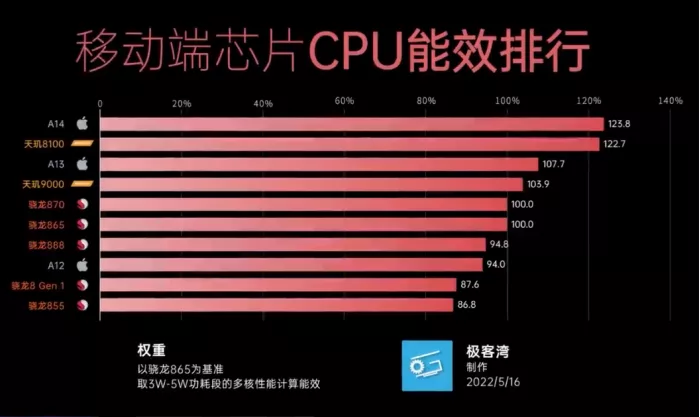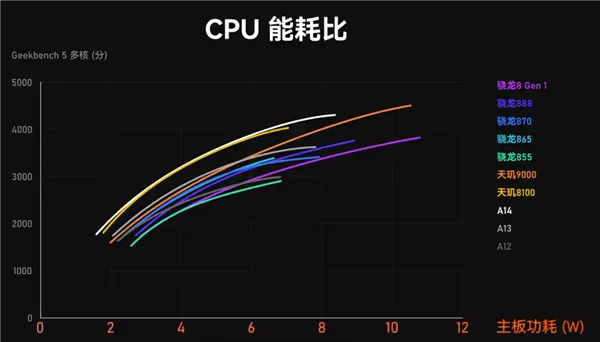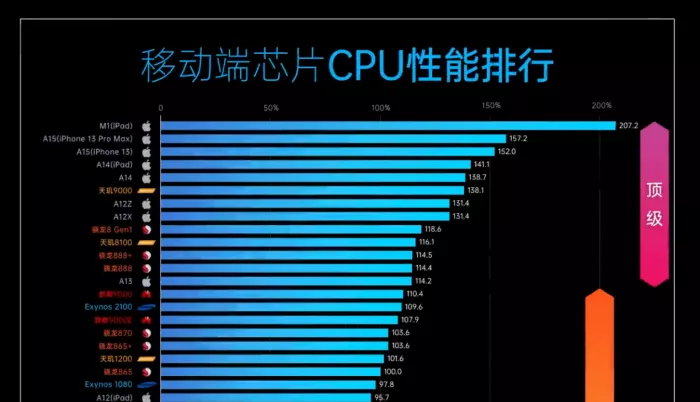In the past two years, while the performance of processor chips has been improved on both desktop and mobile platforms, the problem of power consumption and heating has become more and more prominent. In other words, the energy efficiency (energy consumption ratio) is getting worse and worse. Nowadays, at many new mobile phone product launches, heat dissipation has actually become the core publicity selling point, which is really embarrassing. So, among many mobile chips, whose power consumption control is the best and energy efficiency is the best?
Geek Bay recently passed a massive data test and summarized the energy efficiency ranking of ten high-end mobile phone mobile chips. Let's take a look.

The strength of Apple's A-Series is indeed extraordinary. A14 ranks first, A13 ranks third, and A12 of the previous generation can rank eighth.
There is a gap between Android's flagship A10 and Android's flagship A10, which is far lower than that of other Android platforms. Moreover, the energy efficiency of the A14 is far higher than that of the A14
*MediaTek Tianji 9000 also ranked fourth, second only to A13 *. As a high-performance flagship product, it is not easy.
It can be said that Tianji 9000 / 8000 Series deserves such a ranking with a series of optimizations such as advanced architecture design, 4nm / 5nm process and global power-saving technology.
The best one on Qualcomm's side is Xiaolong 870. Its predecessor, Xiaolong 865, the flagship of the previous generation, is at the same level, while Xiaolong 888 and Xiaolong 8 of these two generations are mediocre.
In particular, the latest Xiaolong 8 has retreated by as much as 12.4% compared with Xiaolong 870 / 865, which is only equivalent to the older Xiaolong 855, that is, the king of fever in that year

On another graph, you can more intuitively see the energy efficiency differences of different SOCS.
In the figure, the horizontal axis is the power consumption of the motherboard, and the number axis is the multi-core performance performance of geekbench 5. It can be seen that Apple A14 (white curve) is high. It has the lowest power consumption when running to the same score, and its score is the highest under the same power consumption.
Except for the lowest and highest power consumption, most of Tianji 8100 (yellow curve) completely coincides with A14, which is surprising. In other words, in daily use, the energy efficiency of Tianji 8100 is no different from A14, and it is a top-level existence
*The performance of Tianji 9000 (orange curve) is slightly lower than that of A13 (gray curve) under low power consumption. It exceeds that under high power consumption and high performance, and has more elastic space *. When necessary, it can sacrifice some power consumption to achieve higher performance, and it is basically linear improvement.
Xiaolong 8 (purple curve) and Xiaolong 855 (cyan curve) are at the bottom under the condition of low power consumption. Although higher performance can also be achieved by increasing power consumption, the improvement range is much smaller.

Finally, the mobile SOC performance ranking is attached. A14 in mobile phone chips continues to be invincible, Tianji 9000 is the first in Android, and Tianji 8100 also catches up with Xiaolong 8.